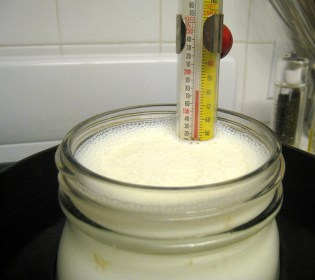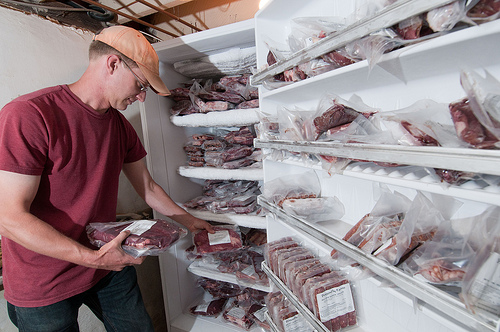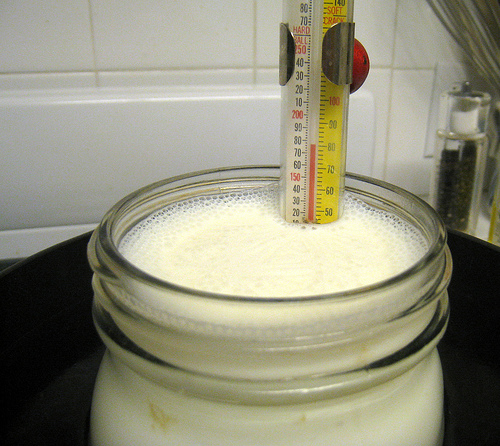
A good thermometer is key when making your own yogurt. (Photo by Dvortygirl.)
The following recipe comes from Vanessa Barrington’s book, D.I.Y. Delicious (Chronicle Books, 2010).
It’s very easy to make yogurt without a yogurt maker. For equipment, you’ll need a two-quart saucepan, a candy or dairy thermometer (optional but helpful), a one-quart mason jar, and a whisk that will fit into it. You also need a method for keeping your yogurt warm while it cultures. Read the FAQ below before getting started.
Makes one quart. Requires 20 minutes active time; 20 minutes passive, but watchful; and eight to 10 hours passive.
Ingredients:
1 quart of the best milk available (I use non-homogenized full-fat organic milk from a local dairy)
2 tablespoons plain yogurt with active cultures or 1 teaspoon powdered yogurt starter
Pour the milk into a large saucepan and turn the heat to medium-low. Heat it slowly, stirring occasionally until it is just below the boiling point, about 20 minutes. Watch carefully and do not allow it to boil. If you have a thermometer, the milk should be about 185 degrees. If you don’t have a thermometer, there are some visual and olfactory cues: Tiny bubbles will form just under the skin that covers the surface of the milk. The surface will undulate slightly but the bubbles shouldn’t break the surface. The milk will have a cheesy, scalded aroma. Once the milk reaches this state, hold it there for five minutes.
While you wait for the milk to come up to temperature, sterilize a one-quart Mason jar and its lid with boiling water. Let air-dry. Warm a large pot of water for a water bath, if you’re using one. (See FAQ below for incubation methods.)
Once the milk has remained at 185 degrees for five minutes, remove it from the heat and let it cool down to 115 degrees, stirring occasionally. This will take about 20 or 30 minutes
Put the yogurt or starter in the bottom of the sterilized mason jar and add about 1/2 cup of the cooled milk. Whisk to blend well. Add the remaining cooled milk, stirring well to distribute the cultures throughout. Fasten the lid and place the jar in your incubator of choice (see FAQ) for eight to 10 hours.
Remove from incubator and refrigerate it until cool before eating. If your yogurt is a little lumpy, simply whisk it smooth before eating. If you would like thicker yogurt, strain it to desired thickness in a coffee filter or tea towel set in a strainer over a bowl. The whey that drains off can be used to soak grains, cook beans, ferment pickles, or make fermented drinks.
Frequently asked questions:
Q. Why make yogurt?
A. It’s easy, and organic milk is less expensive than organic yogurt, so you’ll save money too. You can buy a yogurt maker if you want to go completely foolproof, but all you really need is a starter and a method for keeping your yogurt at a steady 90 to 100 degrees for eight to 10 hours. [Also, see the Grist post, Not your grandma’s yogurt for more on why more people are making their own.]
Q. What kind of starter should I use?
A. In can be as simple as adding 2 tablespoons plain yogurt to a quart of milk. You must make sure the yogurt contains active cultures and is free of additives. You can also buy powdered yogurt culture in some grocery and natural food stores. This method adds an air of predictability and consistency to the process (and is necessary if you forget to hold back some yogurt for the next batch). I’ve found it in small jars in the refrigerated section where dietary supplements are sold. Natren is a good brand and will keep for several months in the refrigerator. The directions on the jar will tell you how much to use. I use 1 teaspoon per quart of milk. You may also purchase yogurt starter from a cheese supply house.
Q. What’s the best way to incubate yogurt?
A. There are several ways to go about keeping your yogurt at a constant incubation temperature: I like to put a quart mason jar of ripening yogurt in a large pot of water heated to about 90-100 degrees. Then I put the yogurt in this water bath in my oven overnight with the light on. This works perfectly. A gas oven with the pilot light on is also a good way to accomplish the same thing. The pot of water helps keep the yogurt at a constant temperature. I’ve also wrapped the jar in a black plastic garbage bag and left it in the sun on an 80 to 85 degree day. Some people put the yogurt in a warm water bath and then set the whole thing in an insulated cooler with towels wrapped around it. Others use a heating pad. You may have to experiment a couple of times until you find the method that works best for you.




